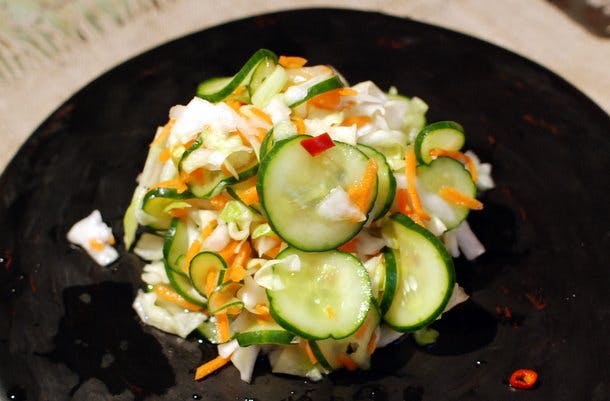
Japanese Quick Pickles
Discover the art of Japanese pickles with unique recipes and flavorful ingredients. Learn how to prepare Mrs. Torimitsu's popular Asazuke, a quick pickle recipe using Japanese cucumber, cabbage, and carrot, seasoned with soy sauce and optional seasonings like minced ginger and myoga.
Like most Americans, I suppose, I grew up with a concept of "pickles" as, basically, heavily vinegared cucumbers. But in Japan I discovered something completely different -- a vast and fascinating world of pickles, lightly cured for the most part to amplify the natural flavors of a wide array of vegetables, and typically infused with aromatics and other ingredients (like rice bran and sake lees) to add even more layers of flavor. (See last year's post on pickles.) They're an integral part of the traditional Japanese meal and a favorite of mine, especially at breakfast. And there are countless regional varieties and family recipes. I've been very interested to learn more about Japanese pickles.
I've recently been in touch with a prodigious cook and cookbook copy editor named Nobuko Torimitsu who graciously sent me a few of her pickle recipes from Japan. Mrs. Torimitsu writes about her pickles:
"The vegetables I use as base ingredients for pickling are typically ones that are available all year long: cucumber, cabbage, daikon, carrot, kabu (turnip), mizuna and eggplant. In the spring, I also use nanohana (rape shoots), and in the winter and spring, Napa cabbage. For additional flavoring, I add ginger, shiso leaves, garlic, togarashi (chili pepper), mikan (mandarin) zest, yuzu zest, lemon peel, karashi (Japanese mustard), myoga (a kind of ginger), among others. In terms of seasoning our main 'spice' is salt. Additionally, I add vinegar, soy sauce, sugar or sesame oil. Here are a few of typical pickles that I serve in my home for breakfast."
Here's the first of Mrs. Torimitsu's pickle recipes -- more to follow in the next post. And if you have your own favorite Japanese pickles, please add them to the comments!
"At our home, these are our most popular, and most often prepared, pickles for breakfast."
Japanese Quick-Pickled Vegetables (Tsukemono)
Ingredients:
- 1 Japanese cucumber, cut into small coins
- 1/8 head of cabbage, shredded
- 1 carrot, peeled and julienned (optional)
- Japanese sea salt
- Soy sauce for seasoning
Optional Seasonings:
- Minced ginger
- Chiffonaded shiso
- Japanese mustard
- Togarashi (dried red chili)
- Minced myoga (Japanese ginger)
Instructions:
-
Prepare the Vegetables: In a large bowl, combine the cucumber, cabbage, and carrot (if using).
-
Season: Add Japanese sea salt to the vegetables, using a ratio of 2% salt to the weight of the vegetables. Mix well to ensure even coating.
-
Add Optional Seasonings: Customize the flavor by adding any of the optional seasonings to your taste. Options include minced ginger, shiso, Japanese mustard, togarashi, or minced myoga.
-
Rest and Release Liquid: Allow the mixture to rest in the refrigerator for 30 minutes. During this time, the salt will draw moisture out of the vegetables.
-
Squeeze Out Excess Liquid: After resting, squeeze the vegetables to remove the excess liquid. If the vegetables are too salty, they can be briefly rinsed with water.
-
Season and Serve: Just before serving, season the vegetables with a few drops of soy sauce for added flavor.
[NOTE: Japanese sea salt is full of minerals and with a richer, more concentrated flavor than ordinary table salt (there are no salt deposits in Japan). Also, some Japanese sea salt comes still moist with sea water, which adds an incredible brininess to the salt. Available at Japanese markets.]
